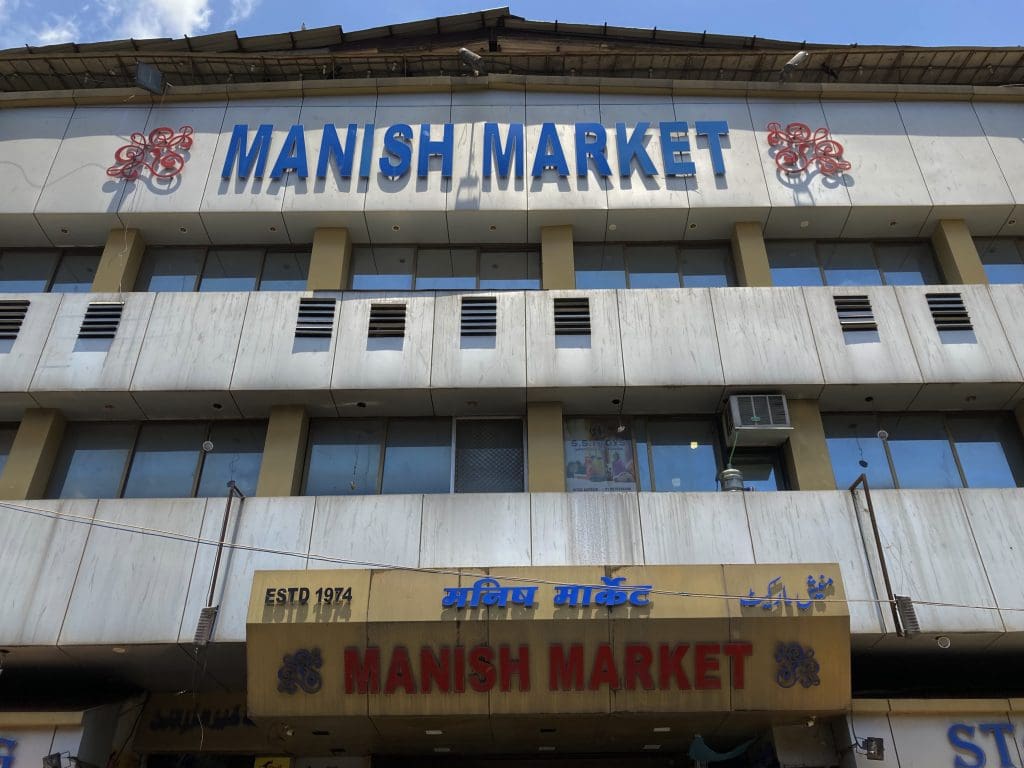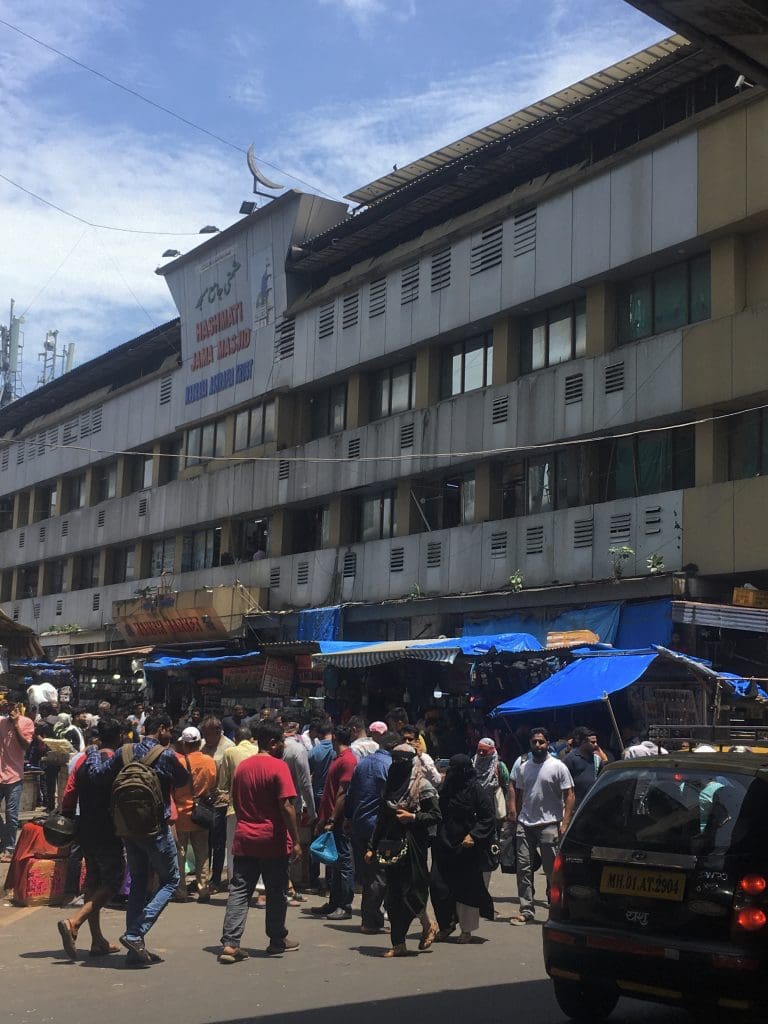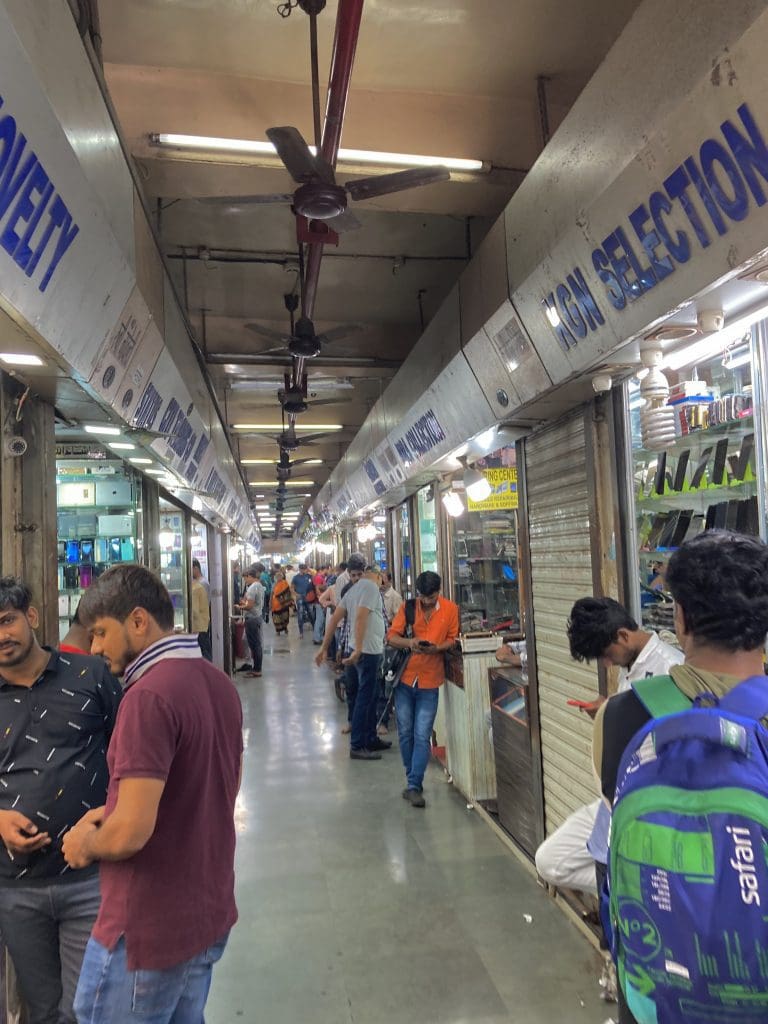
Slimy floors from accumulated compost of generations, shafts of sunlight filtering through, with Mumbai’s most ubiquitous crows and fattest rats in town with vicious cats chasing them around, Crawford Market is a name that people of Mumbai will seldom forget.
Now renamed Mahatma Jyotirao Phule Market is primarily known for its fresh produce market. A small walk from Crawford Market lies its “cousin” market of electronics named Manish Market. The lanes are narrow and there are carts, haathgaadis, tempos, small trucks and taxis without an inch to spare, with a sincere disregard for traffic signals and an omnipresent redolence of fish.
“The stock includes a sizable proportion of very convincing fakes,” says Myriam Kaye in her The Illustrated Guide to Bombay.
While not known for its grandiosity, Manish Market is well-known for its intricate repairman work and first copy electronics, with some 200 plus shops in the building which stand 4 floors tall. The first two floors are shops while the third floor is a godown and the fourth floor is a Masjid, named Hashmati Jama Masjid, an initiative by Madrasa Ashrafa Trust.
Salman, a 27-year-old, has worked at Manish Market since 2012. He learned the work of repairing electronics from his cousin and moved from Uttar Pradesh to Mumbai some roughly 8 years back. Salman started working with his cousin and now has two shops in the market. He pays 30 thousand in rent for his second shop, roughly 100 sq ft in area. However, the rents tend to range from 80,000 to 1,25,000.


Salman says that if he had the resources, he would’ve liked to study engineering. Being the eldest of his 5 siblings, he was not awarded the luxury to choose what he wants to do with his life. When asked about how he chose this line of work.
He said “Aap log chose karte honge, hume joh bola gaya hai wo karna padta hai” [People like you have the luxury to choose what you want to do, we need to do what is told to us].
“I finished my 12th, and then started working because I am the eldest of all my 5 siblings. My two sisters are in 10th standard, I want to educate them”.
Many men like Salman have learned the skill sets from their families, and now work here, most times out of necessity. With no money, no other options for other lines of work or any “backups”, as Salman says, he was left to take up a job at the Market.
When asked about the easiest part of his job, Salman laughed it off and said that sleeping is perhaps the easiest.
I asked him about what he thinks is the difference between big companies’ technicians and repairmen like him. He said, “Big companies work to replace the item, while we work to repair. We intend to save the piece. Most big companies will compensate a meagre amount and discard the electronics.
People come to us to save the electronic, not to throw it out.”
When shopping at Manish Market, customers are aware that the products they are buying are first copies or second copies of the brands. However, most complaints from customers come for repairing works, known for “cheating” the customers or duping their original parts for copies.
However, most repairers believe that a few bad apples among them ruin the name of the rest. Repairmen have a stigma attached to their work because of this.
Many times repairmen like Salman would buy an electronic from a customer, only to find out that the piece was stolen. The original owner would then either file a case or complain to the police. If a case is filed, repairmen would’ve had to do “court kacheri”. This has led repairmen to grow weary of buying products from unknown or “shady” customers, because of the ill-reputation that follows them around.


During the pandemic, most of the workers went back to their villages. Shops stayed shut for about 2-3 months at the start of the pandemic. With the start of the shops, the business was slow with time constraints adding restraint.
With the new BMC (Brihanmumbai Municipal Corporation) guidelines of only one side of shops being opened, many found it difficult to sustain their work.
Crawford Market is one of the first Municipal Markets in Mumbai. It dates back to 1869 and was named after Arthur Crawford, the first municipal commissioner of Bombay. Despite being under BMC, it is now the subject of a bitter dispute between urban conservationists and the municipal corporation, which wants to build three large mall-like buildings in the courtyard.
Many markets like Linking Road of Bandra, Fashion Street of Churchgate, Fruits, vegetables and flower market of Dadar, and Colaba Causeway of Colaba regularly run into struggles with BMC, as these are primarily roadside shopping centres, where vendors sell their goods on pavements.
It is because of the low prices and the atmosphere of bargaining that hawkers in Mumbai offer, that it is famed for its street shopping all over the city.
But, amid the chaos of this daily routine, there is one word all vendors are accustomed to hearing as a warning sign to pause for the day: “Gaadi,” meaning vehicle. It is code for the arrival of the BMC anti-encroachment jeep.
Word travels through the veins of the roads in shouts, echoes and signals from one end to the other. In an almost choreographed manner, the hawkers wind up. Transactions are cut short and shoppers swept aside.
Within minutes, the hawkers disperse into one of the many small lanes and wait for the gaadi to pass.
While the 1985’s Supreme Court’s decision trod a middle ground. It maintained that public streets were meant for the general public, keeping evictions legal. But it also upheld the constitutional right to hawk, as long as it was within municipal norms.
Manish Market has shops outside as well, which frequently run into tussles with BMC and police. All of them have to renew their licenses yearly, failing to do so indicates regular abolition of their shops. Despite being under BMC, Crawford market has faced regular demolition drives (by the BMC), and street shopping stretches like Causeway and Fashion Street whisper that bribery has led them to sustain their shops.
However, Manish Market has never encountered a problem with BMC. Most owners of the shops have had their paperwork cleared out years ago, which has never led a BMC official to set foot in the building for encroachment. A BMC official, when asked about Manish Market, said that all the owners of the shops have meticulous paperwork, and most of the problems within the community are sorted internally without involving the police or BMC.
However, another whispered name that goes around in circles which is to be thanked for the smooth functioning of the market is the Dossa family.
Dossa family
Manish Market building is primarily run by Haroon Dossa, the younger brother of Mustafa Dossa.
In 2003, Mustafa Dossa was arrested and found guilty of holding meetings in India and Dubai conspiring in the 1993 blasts. The TADA (Terrorism and Disruptive Activities (Prevention) Act, 1987) court convicted him for landing arms and ammunition and explosives in Rajgad and financing the landing and making travel arrangements for people who met with Dawood Ibrahim Kaskar.
Born to a family of oil merchants in Agripada, Mustafa was the second among Ahmad Umar’s three sons. Dossa was born into an upper-middle-class family in Bhavnagar, Gujarat to Ahmed Umar Dossa and Amina.
His father worked with his uncles at the oil mill run by his grandfather, Umar, but differences between the siblings led to Ahmed moving out in 1965. In 1974, Ahmed bought a shop in Manish Market for ₹75,000 and made his sons Mustafa, Mohammad and Haroon partners. The Kutchi-Memon Dossa clan controls the wholesale trade at the Crawford market.
Like his elder sibling, Mohammad, and younger, Haroon, Mustafa, too, was a school dropout and joined his family business in the early 1970s. However, as soon as Mohammad joined hands with gold smuggler Haji Mohammad, in the late 1970s, Mustafa followed suit. It is said Mohammad introduced Tiger Memon, (also a key bomb blast accused), into the smuggling syndicate as a driver, to begin with.
Soon after, Mohammad migrated to Dubai to join Dawood Ibrahim. Mustafa, too, fled to the UAE in 1988. Underworld observers said the Dossa family’s fortunes changed after Mohammad and Mustafa flooded the black market with gold and electronic goods smuggled from Dubai.


Some believe that Manish Market was a clothes market some odd 50 years back, named Nustan Pusbak. At the same time, some think that it was always an electronics market named Musafir Khana.
However, The Dossa family purchased a radio theatre near Crawford market and built the first electronic goods market in south Mumbai, Manish Market, in its place. However, soon after, Mohammad sold off his share in the shop and bought another in the same market complex in 1976.
In Dubai, too, the Dossa brothers built one of the biggest gold jewellery showrooms at Gold Souk, called Mignas, which is still the family’s rice bowl, apart from the earnings from the rent paid by shops at Manish Market.
In fact, the top floor of Manish Market was converted into a mosque following Ahmad Umar’s death, at the instance of Mustafa.
Ahmad Umar was a follower of Sufism and the mosque is meant for Barelvi Muslims.
Amit K, a local resident near the market, said that the market is a mystery to most people, even those like him who have lived there since their births.
“The mechanics of their work or how they sustain themselves is rather a taboo thing to talk about,” he says.
The influence of Dossa has historically made the local residents stay out of matters of the market, with rumours flying around of serious repercussions for those who try to mingle within. The only time local residents were offered a glimpse into the market was during the 2012’s Sahara Market and Manish Market’s major fire breakout which gutted 2000 shops. Although there were no casualties, the losses have been estimated at nearly Rs 200 crore.
While the fire brigade claimed that the blaze that gutted the Sara-Sahara shopping complex and Manish Market in 2012 was due to short-circuit, former chairman of Manish Market, Mohammed Ismail Jaan Mohammed, had alleged sabotage.
He claimed that Mustafa Dossa’s aides had started the fire. He also blamed Haroon Dossa, the secretary of Manish Market.
Soon after Mustafa Dossa’s death word spread in 2017, shops in Manish market started downing their shutters. Most shops, shopkeepers said, were owned, aided or financed by the Dossa family. A notice on the building said the market would remain shut for 2 days. Many shopkeepers and owners in the Market claim that the Dossa family has put a roof over their heads and sustained them through tough times all these years.
Many men employ their relatives in the shops and provide employment to them through familial connections. Eventually, these young men get included in the trade businesses as well and run the shops together with the older generations.
While the exact figures of turnover of the market remain a rather taboo thing to talk about, the shops get their export directly from China, now. Local residents claim that huge truck-like containers paint the road after 10 pm every night, with the cost of each truck ranging from 40-50 lakhs. Old local residents say that the Market was the only place where you could find imported pagers and watches. Today, one can find copies of big brand names, quite easily in the market.
For many people, the name means everything. People who cannot buy the original price ranges of a product are willing to buy the copy for the brand recognition that the product brings with itself. With the huge disparity of generationally wealthy and nouveau riche – ‘new money rich’ environment that Mumbai prides itself on, copies of big brand names let people of Mumbai taste the better life.
Throughout all these years, the name and reputation of Market have stayed the same. Back then people weren’t able to purchase imported goods either. Manish Market, like today, made electronics accessible to all without hefty import prices, and customs levied on them.
Sakshi Sadashiv K is an undergraduate student at Sophia College for Women, Mumbai.



